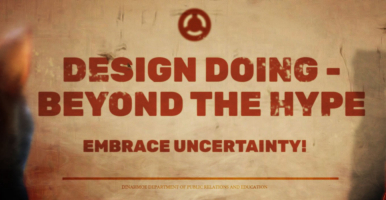Design Doing – Design Thinking for the impatient!
Take the fast lane and leave the wicked problems behind!It doesn’t matter how much I try, Design Thinking feels very backwards to me. I am not saying that it doesn’t work, I think creative people will be creative in almost any system, and maybe there are use cases where it would make sense.
But as a whole it seems overly complex and time consuming, and does more to reduce risk than to encourage creativity and innovation. We’ll come to that. But first some taste samples.
The different flavors of Design Thinking
The definition of Design Thinking varies depending on who you ask.
Stanford d.school explains their flavor perfectly in a crash course that you can find here. It is based on the following steps or “modes”:

IDEO, one of the first agencies to focus on DT presents the phases in the process like this:
and explains DT like this:
Design thinking is a process for creative problem solvingDesign thinking utilizes elements from the designer’s toolkit like empathy and experimentation to arrive at innovative solutions. By using design thinking, you make decisions based on what future customers really want instead of relying only on historical data or making risky bets based on instinct instead of evidence.
Stanford Graduate School of Business adds some steps in the process:
In the Stanford LEAD course they state
It is becoming increasingly recognized that innovations that succeed follow a systematic, rigorous process of need identification, hypothesis generation, testing, learning, and iteration.
I think that Nassim Taleb would strongly disagree with that 😜 but never mind. They define DT as:
a systematic innovation process that is both a toolbox for stimulating creativity and a methodology for defining and solving problems.
Sounds pretty good and useful, right?
“Let’s not jump to conclusions”
It seems to me that the effect (or maybe even purpose) of Design Thinking is not to encourage creativity, but to slow down the creative process. Here is a quote from d.school:
The problems you’re trying to solve are rarely your own, they’re those of particular users.
That can be true, far from always, but anyway. So what does that mean in the DT world? To be a little provocative:
Don’t even think that you know the solution!
“I know the solution!” Maybe, but first we need to frame a question!”
“But I know the solution!” “ Of course, but now we need to get inspired!”
“I already know…” “ That’s awesome! Put your idea in the basket with all the other high quality ideas generated by brainstorming!”
“But…” “Time for prototyping, testing, iteration of selected ideas. Isn’t Design Thinking creative and fun?!”
“…”
The whole process seems to be designed to avoid mistakes, rectify false assumptions, remove risky decisions. Isn’t that the total opposite of creativity and innovation?
Of course I am generalizing and simplifying. Of course the process must be adapted since each project is unique. But if you remove the core “modes” of Design Thinking, then what is left? It is for sure no longer Design Thinking, and you can no longer tribute great results to the process but to the people involved.
Please let me propose a simpler system. Design Doing!
What is Design Doing?
Ok, I just made the term up and it needs a better name, I am open for suggestions. In any case the method is no joke, it is real and proven in real world scenarios again and again. Here is the process flow:

If reality moves along according to plan then all is well but if something feels complicated… Step 1 in the creative process is to listen to that little voice that says: “there must be a better way”.

I call this the Innovation Trigger. It makes you aware that there is an opportunity to innovate! So this is step 1.
Step 2 is to envision how it should be, how it should work. What would the perfect version of this be? In many cases you probably have an idea of how that might look like. Make this idea as clear as possible, use whatever tools you need to visualize the idea and make it concrete.

Try this ideal solution on others. Is it a vision worth pursuing? Does it hold up to scrutiny? Always remember that users don’t always know what they want and need until it is real. This could result in both overly positive and negative feedback.
Step 3 is to identify what holds reality back from not already being perfect. What are the problems that, if solved, would allow the goal to become reality? Please note that the problems themselves are not in focus, they are just there to be solved.

Problems can be one or many depending on the complexity, e.g. you have lost your keys or want to solve global warming.
Step 4 is to solve the problems one by one and check them off the list. Use the goal and vision as a compass to judge whether solving one of the problems brings you closer to the goal or not. If you are closer then you are probably on the right track. Prototypes and testing should be used when needed.

And when you have solved all the problems, then you are at step 5 and have arrived!

A side by side comparison
So what is the benefits of Design Doing compared to Design Thinking?
- it focuses on the goal and vision. DT focuses on the process.
- it can be used by individuals and teams of any size. DT is very hard to execute without a larger team.
- process time depends on the complexity of the task. DT will always have a considerable startup time. This and the larger teams makes it unsuitable for anything else than complex tasks.
- the vision and goal provides a compass that make it possible to judge progress. The progress in DT is hard to judge until there is a viable solution.
- the problems are not important in themselves, and are often resolved by solving other problems. DT uses brainstorming to generate multiple ideas that then has to be made tangible in prototypes and tested. Once again the focus is on the process, not the goal, and it will always be very time consuming.
- it is easy to implement in an organisation and doesn’t require any changes to processes or roles. DT requires that the whole organisation understands, appreciates and at least partly adapts to the process.
Design Doing is creative, positive, lightweight, flexible, powerful, efficient, pragmatic, goal oriented. And it is free! What’s not to like?
But what about the “wicked problems”?
I am so glad you asked! Design Thinking is sometimes said to be able to solve what is called “wicked problems”. The term was coined by Horst Rittel (1930–1990), a design theorist and university professor, to describe complex public policy decision making.
This could be a post in itself but here is the short version. I tend to agree with B.Guy Peters that most problems aren’t really “wicked” at all. My experience in public policies are limited to say the least but I think Design Doing (really need a better name) could be a great foundation for “wicked problem” solving! Here are my comments to the Rittel’s numbered list of what defines “wicked problems”.
- by defining the end result we create a definitive formulation
- the goal is the stopping rule
- since there is a stopping rule there is a true and false state
- a goal can be achieved in several ways by solving different and seeminlgy unrelated problems, some of which can be implemented and tested.
- see 4.
- see 1.
- see 4.
- see 1. complex problems always consist of several problems.
- see 1.
- life is a bitch
Conclusion
I could write a long disclaimer here since reality of course is not that black and white, and there are for sure things that I don’t know and understand. But please feel free to trash my ideas in the comments, and then we’ll take if from there 🙂.
One note to those who have read 5 simple steps that will make you a creative genius. The process above is essentially the same but described from a different view point. Eventually I will update the terminology in “simple steps”, in any case the core message is still valid.
So now it is up to you:
Do you prefer a problem to solve or an opportunity to innovate?
Read the exciting part 2 here:Design Doing — Beyond the Hype






